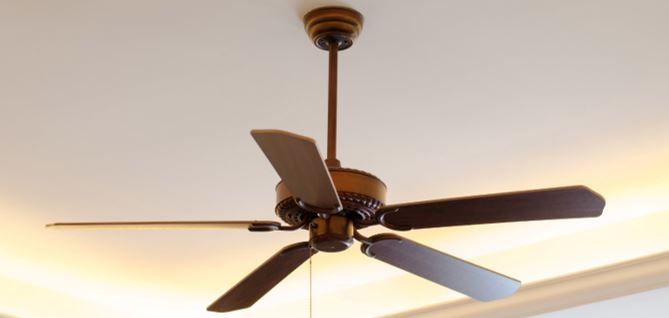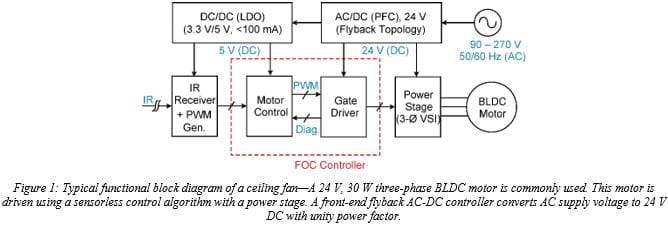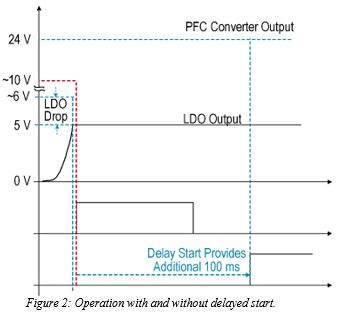Reduce Design Time by Simplifying Code Development in Ceiling Fan Applications

Introduction
To cater to the needs of smart and energy-efficient ceiling fans, the market trend has shifted from conventional single-phase-induction motor-based fans to energy-efficient brushless-DC (BLDC) motors. Compared to traditional ceiling fans, a typical BLDC fan (see Figure 1) provides higher efficiency, power factor, and power density, which allows a smaller motor. However, ceiling fan application requirements give rise to multiple system-level challenges that must be addressed in the BLDC motor driver, typically using extensive development of specialized coding. This article discusses those challenges and highlights how existing code-free field-oriented-control (FOC) sensorless BLDC motor controllers solve the challenges in ceiling fan applications.

Challenges in Modern Ceiling Fans
Modern ceiling fan designers face many challenges that require code development to ensure:
- Accurate rotor IPD data at startup with sensorless operation: At startup, incorrect initial position detection (IPD) of a rotor can lead to reverse rotation or dangerous oscillations. The align-and-go algorithm traditionally used in sensorless starting of a BLDC fan can lead to blades moving in the reverse direction to allow alignment before rotation begins in the desired direction. This reverse movement is perceived as a safety concern in ceiling fan applications.
- Stable supply voltage: Accurate rotor IPD data requires a stable supply voltage, especially when presented with the huge inrush of current at startup. The voltage of the power-factor correction (PFC) converter must be stabilized before starting the IPD operation. This is achieved by delaying the startup to accommodate this inrush, which ensures reliable position detection.
- Reliable startup in the correct direction: The fan must start reliably during forward- or reverse-windmilling operation. In forward-windmilling operation, if the fan is already rotating in the desired direction and the motor is commanded to turn on, the controller must determine if the motor needs to be completely stopped or if it has sufficient back-electromotive force (emf) to continue rotating in the sensorless mode of operation. Whereas, in reverse-windmilling operation, if the motor is rotating in the undesired direction, the motor is first halted completely, then restarted in the desired direction.
- Compatibility with installation environment: The varied couplings used to mount ceiling fans impact motor starting performance. The motor driver algorithm should account for these system-level issues.
- Safe, efficient motor control with constant-speed operation: Speed control is crucial to limiting the peak input power of the system and to preventing excessive power dissipation in the driver, which can result in damage.
- Fault detection and reporting: Various fault conditions—such as blocked-rotor, overspeed, overcurrent, vibration, or open phase—must be detected and reported.
The development of specialized software that addresses these challenges requires extensive system and microcontroller knowledge and increases the overall research and development time and cost.
Integrated Algorithms that Eliminate Coding
Designers can simplify and reduce time in development by integrating drivers that are purpose-designed with algorithms that eliminate the need for coding during system development. On-the-market solutions include the QuietMotion family of 50 V, three-phase sensorless BLDC motor (FOC) gate drivers from Allegro. This family includes proprietary high-performance algorithms designed to achieve sensorless operation with the best efficiency and superior acoustic noise performance without requiring software development. Features enabled by the fully integrated proprietary Allegro algorithms include:
- High efficiency over a wide range of operation using a sinusoidal FOC algorithm to phase-align back-emf and motor current.
- Nonreverse fast startup and correct position data from startup using an advanced two-pulse IPD algorithm.
- Proper IPD and smooth startup enabled by a 100 ms startup delay that allows sufficient time for PFC voltage regulation. Typical startup using a QuietMotion device with delayed IPD is shown in Figure 2.
- Smooth on-off transitions for forward- and reverse-windmilling situations, enabled by a soft-on, soft-off capability integrated in the motor controller.
- Regulation of speed variation and power variation with load, using closed-loop speed control and closed-loop power control to ensure operation and input power remain within the specified limits.
- Protection features integrated in the gate controller to protect the motor and driver in the event of a faulty scenario, including current limit, overcurrent protection (VDS sensing), programmable safe braking thresholds, undervoltage lockout, overvoltage protection, lock detection, open-phase protection, vibration lock detection, over-speed protection, and thermal shutdown.
- Programming and tuning of application-specific parameters—including speed, current, power, speed profile, and resistance, among others—directly via a simple I2C interface in the EEPROM of the controller.
The quick and easy tuning of these motor drivers enables rapid application integration, thus reducing development time and cost.

Finding the Best Cost-Saving, Code-Free Solution
The QuietMotion family of FOC gate controllers is equipped with the essential features required for the control of ceiling fans, including an FOC algorithm purpose-built for ceiling fan application to deliver a code-free environment that achieves the best efficiency and acoustic performance. To learn more about QuietMotion and to select the best device for design-specific requirements, refer to the additional features provided in Table 1. Using the QuietMotion solution can eliminate the development of software code development, design time, and the related cost can be reduced.

Based on the article, "Reduce Design Time by Simplifying Code Development in Ceiling Fan Applications" by Vashist Bist and Shashank Wekhande, originally published in . Republished with permission. For portions not copyrighted by original publisher, Copyright ©2023, Allegro MicroSystems, Inc.
Copyright 2023, Allegro Microsystems.
The information contained in this document does not constitute any representation, warranty, assurance, guaranty, or inducement by Allegro to the customer with respect to the subject matter of this document. The information being provided does not guarantee that a process based on this information will be reliable, or that Allegro has explored all of the possible failure modes. It is the customer's responsibility to do sufficient qualification testing of the final product to ensure that it is reliable and meets all design requirements.
Copies of this document are considered uncontrolled documents.
